2013.5 Peugeot 308 CC engine
[x] Cancel search: enginePage 87 of 268
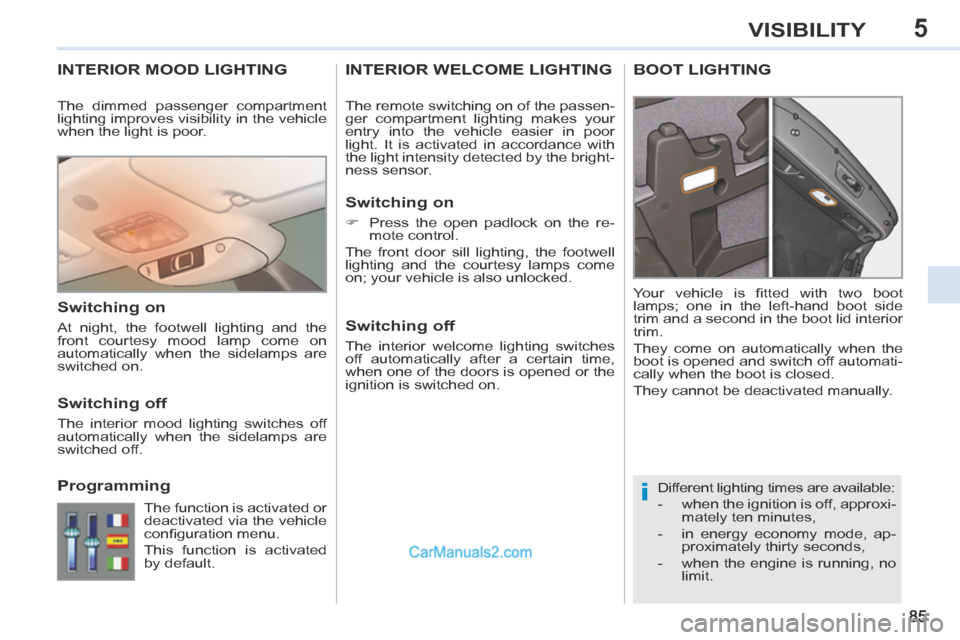
5
i
85
VISIBILITY
INTERIOR MOOD LIGHTING
Different lighting times are available:
- when the ignition is off, approxi-mately ten minutes,
- in energy economy mode, ap- proximately thirty seconds,
- when the engine is running, no limit.
Your vehicle is fi tted with two boot
lamps; one in the left-hand boot side
trim and a second in the boot lid interior
trim.
They come on automatically when the
boot is opened and switch off automati-
cally when the boot is closed.
They cannot be deactivated manually.
INTERIOR WELCOME LIGHTING BOOT LIGHTING
The remote switching on of the passen-
ger compartment lighting makes your
entry into the vehicle easier in poor
light. It is activated in accordance with
the light intensity detected by the bright-
ness sensor.
Switching on
Press the open padlock on the re-
mote control.
The front door sill lighting, the footwell
lighting and the courtesy lamps come
on; your vehicle is also unlocked.
Switching off
The interior welcome lighting switches
off automatically after a certain time,
when one of the doors is opened or the
ignition is switched on.
The dimmed passenger compartment
lighting improves visibility in the vehicle
when the light is poor.
Switching on
At night, the footwell lighting and the
front courtesy mood lamp come on
automatically when the sidelamps are
switched on.
Switching off
The interior mood lighting switches off
automatically when the sidelamps are
switched off.
Programming
The function is activated or
deactivated via the vehicle
confi guration menu.
This function is activated
by default.
Page 97 of 268
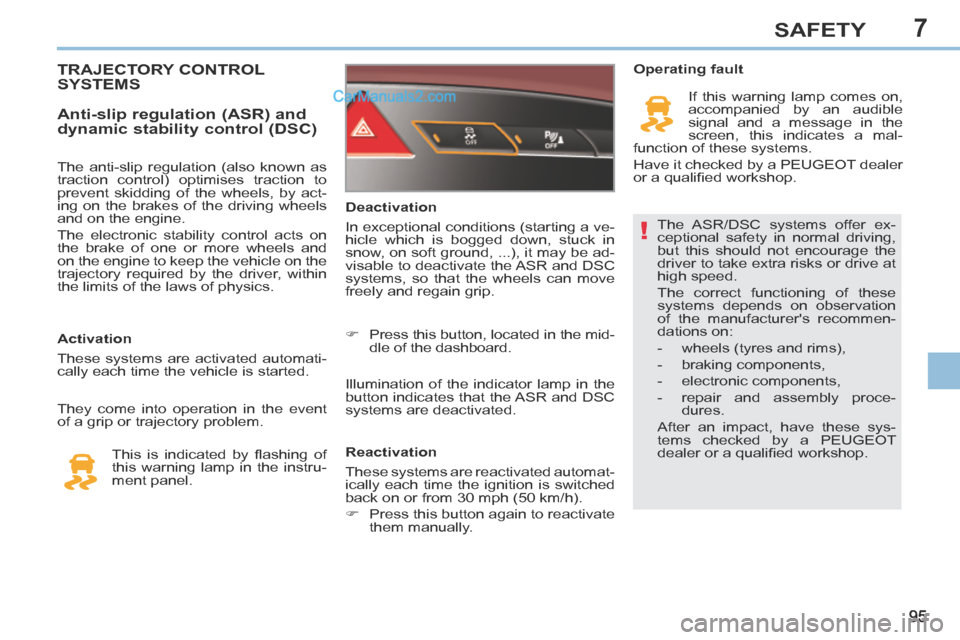
7
!
95
SAFETY
The ASR/DSC systems offer ex-
ceptional safety in normal driving,
but this should not encourage the
driver to take extra risks or drive at
high speed.
The correct functioning of these
systems depends on observation
of the manufacturer's recommen-
dations on:
- wheels (tyres and rims),
- braking components,
- electronic components,
- repair and assembly proce-dures.
After an impact, have these sys-
tems checked by a PEUGEOT
dealer or a qualifi ed workshop.
Deactivation
In exceptional conditions (starting a ve-
hicle which is bogged down, stuck in
snow, on soft ground, ...), it may be ad-
visable to deactivate the ASR and DSC
systems, so that the wheels can move
freely and regain grip.
Press this button, located in the mid- dle of the dashboard.
Illumination of the indicator lamp in the
button indicates that the ASR and DSC
systems are deactivated.
Reactivation
These systems are reactivated automat-
ically each time the ignition is switched
back on or from 30 mph (50 km/h).
Press this button again to reactivate them manually. Operating fault
If this warning lamp comes on,
accompanied by an audible
signal and a message in the
screen, this indicates a mal-
function of these systems.
Have it checked by a PEUGEOT dealer
or a qualifi ed workshop.
TRAJECTORY CONTROL SYSTEMS
Activation
These systems are activated automati-
cally each time the vehicle is started.
Anti-slip regulation (ASR) and
dynamic stability control (DSC)
They come into operation in the event
of a grip or trajectory problem.
This is indicated by fl ashing of
this warning lamp in the instru-
ment panel.
The anti-slip regulation (also known as
traction control) optimises traction to
prevent skidding of the wheels, by act-
ing on the brakes of the driving wheels
and on the engine.
The electronic stability control acts on
the brake of one or more wheels and
on the engine to keep the vehicle on the
trajectory required by the driver, within
the limits of the laws of physics.
Page 100 of 268
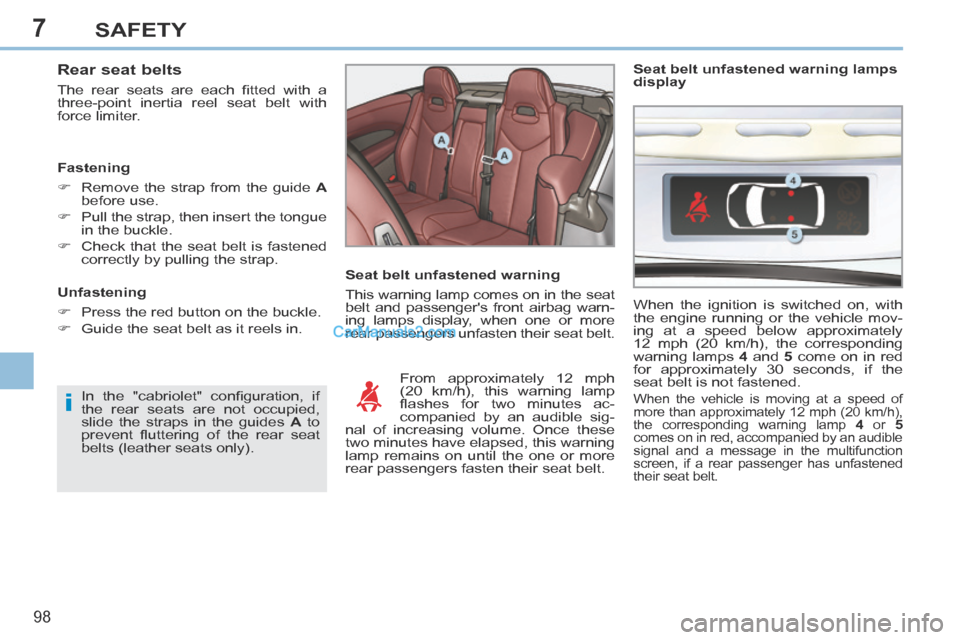
7
i
98
SAFETY
Rear seat belts
The rear seats are each fi tted with a
three-point inertia reel seat belt with
force limiter.
Fastening
Remove the strap from the guide A
before use.
Pull the strap, then insert the tongue in the buckle.
Check that the seat belt is fastened correctly by pulling the strap. Seat belt unfastened warning lamps
display
When the ignition is switched on, with
the engine running or the vehicle mov-
ing at a speed below approximately
12 mph (20 km/h), the corresponding
warning lamps
4 and 5 come on in red
for approximately 30 seconds, if the
seat belt is not fastened.
When the vehicle is moving at a speed of
more than approximately 12 mph (20 km/h),
the corresponding warning lamp 4 or 5
comes on in red, accompanied by an audible
signal and a message in the multifunction
screen, if a rear passenger has unfastened
their seat belt.
Unfastening
Press the red button on the buckle.
Guide the seat belt as it reels in. Seat belt unfastened warning
This warning lamp comes on in the seat
belt and passenger's front airbag warn-
ing lamps display, when one or more
rear passengers unfasten their seat belt.
In the "cabriolet" confi guration, if
the rear seats are not occupied,
slide the straps in the guides A to
prevent fl uttering of the rear seat
belts (leather seats only). From approximately 12 mph
(20 km/h), this warning lamp
fl ashes for two minutes ac-
companied by an audible sig-
nal of increasing volume. Once these
two minutes have elapsed, this warning
lamp remains on until the one or more
rear passengers fasten their seat belt.
Page 116 of 268
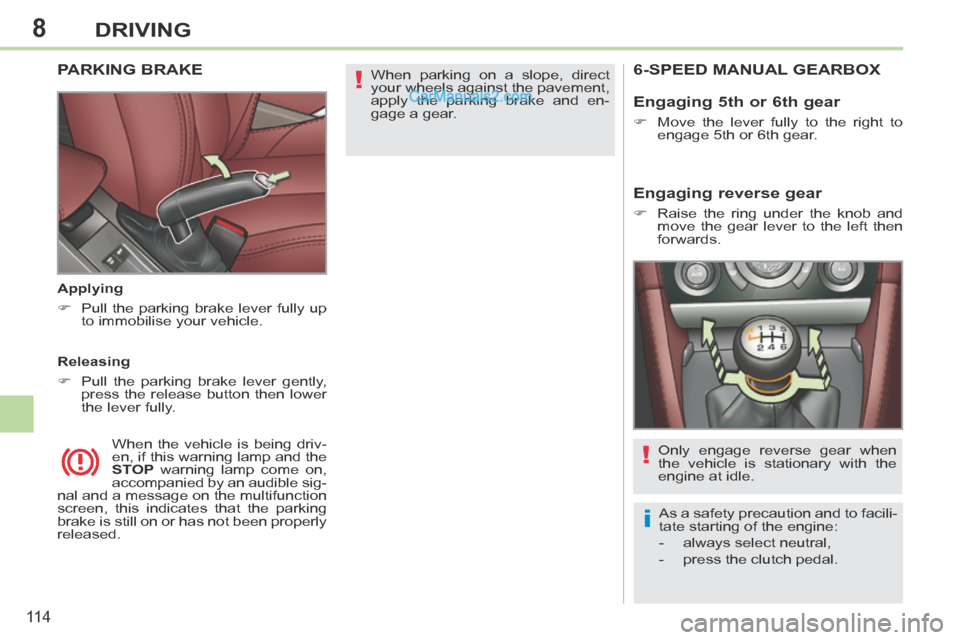
8
!
i
!
11 4
DRIVING
When parking on a slope, direct
your wheels against the pavement,
apply the parking brake and en-
gage a gear. PARKING BRAKE
Applying
Pull the parking brake lever fully up to immobilise your vehicle.
When the vehicle is being driv-
en, if this warning lamp and the
STOP warning lamp come on,
accompanied by an audible sig-
nal and a message on the multifunction
screen, this indicates that the parking
brake is still on or has not been properly
released. Releasing
Pull the parking brake lever gently, press the release button then lower
the lever fully.
6-SPEED MANUAL GEARBOX
As a safety precaution and to facili-
tate starting of the engine:
- always select neutral,
- press the clutch pedal.
Only engage reverse gear when
the vehicle is stationary with the
engine at idle.
Engaging reverse gear
Raise the ring under the knob and
move the gear lever to the left then
forwards.
Engaging 5 th or 6 th gear
Move the lever fully to the right to engage 5 th or 6 th gear.
Page 118 of 268
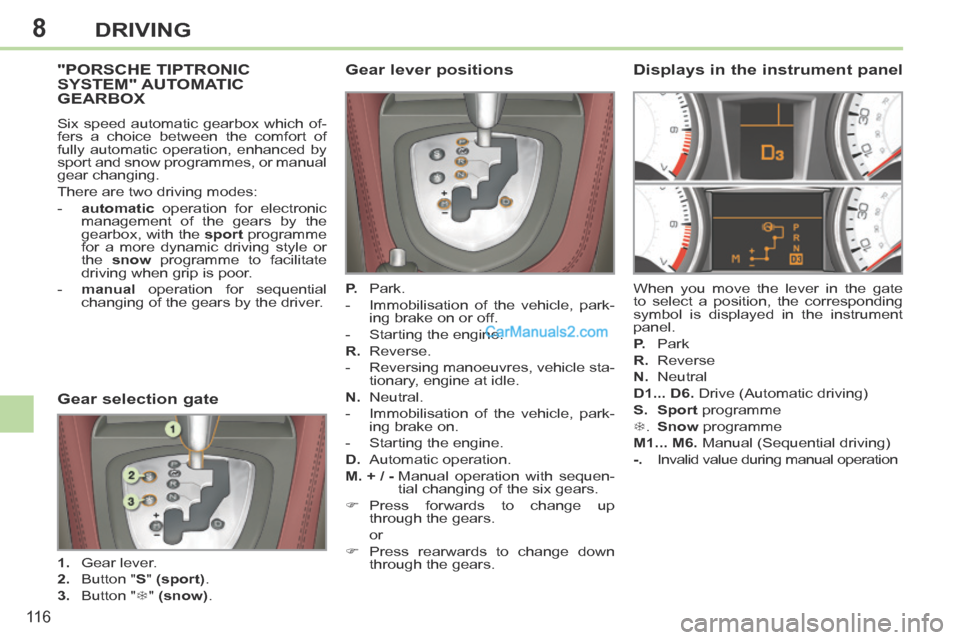
8
11 6
DRIVING
"PORSCHE TIPTRONIC SYSTEM" AUTOMATIC GEARBOX
Six speed automatic gearbox which of-
fers a choice between the comfort of
fully automatic operation, enhanced by
sport and snow programmes, or manual
gear changing.
There are two driving modes:
- automatic operation for electronic management of the gears by the
gearbox, with the sport programme
for a more dynamic driving style or
the snow programme to facilitate
driving when grip is poor.
- manual operation for sequential changing of the gears by the driver.
Gear lever positions
P. Park.
- Immobilisation of the vehicle, park- ing brake on or off.
- Starting the engine.
R. Reverse.
- Reversing manoeuvres, vehicle sta- tionary, engine at idle.
N. Neutral.
- Immobilisation of the vehicle, park- ing brake on.
- Starting the engine.
D. Automatic operation.
M. + / - Manual operation with sequen- tial changing of the six gears.
Press forwards to change up through the gears.
or
Press rearwards to change down through the gears.
Displays in the instrument panel
When you move the lever in the gate
to select a position, the corresponding
symbol is displayed in the instrument
panel.
P. Park
R. Reverse
N. Neutral
D1... D6. Drive (Automatic driving)
S. Sport programme
. Snow programme
M1... M6. Manual (Sequential driving)
-. Invalid value during manual operation
Gear selection gate
1. Gear lever.
2. Button "S" (sport) .
3. Button " " (snow) .
Page 119 of 268
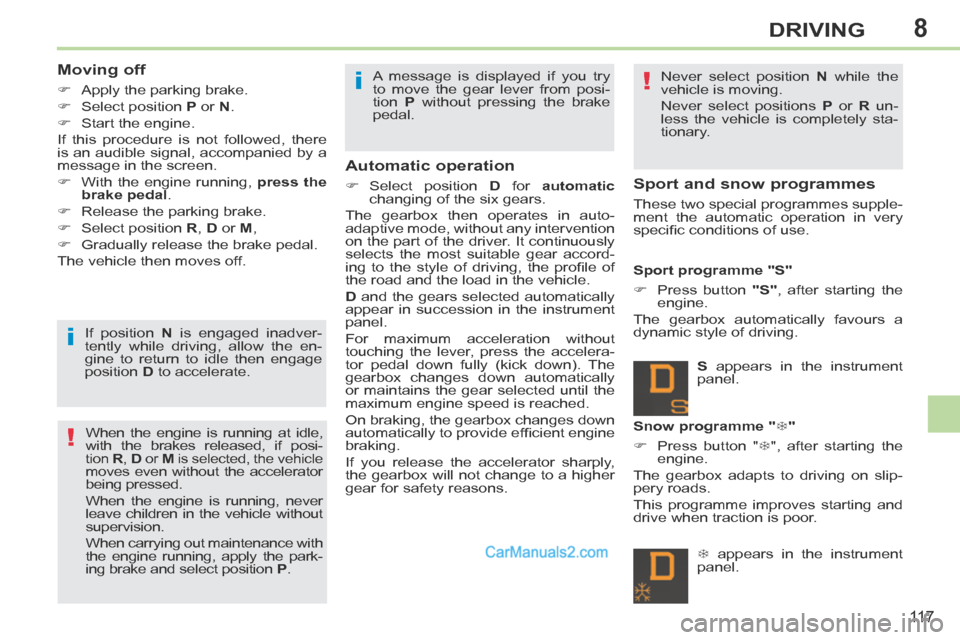
8
!
!
i
i
11 7
DRIVING
Moving off
Apply the parking brake.
Select position P or N .
Start the engine.
If this procedure is not followed, there
is an audible signal, accompanied by a
message in the screen.
With the engine running, press the brake pedal.
Release the parking brake.
Select position R , D or M ,
Gradually release the brake pedal.
The vehicle then moves off.
If position N is engaged inadver-
tently while driving, allow the en-
gine to return to idle then engage
position D to accelerate.
When the engine is running at idle,
with the brakes released, if posi-
tion R , D or M is selected, the vehicle moves even without the accelerator
being pressed.
When the engine is running, never
leave children in the vehicle without
supervision.
When carrying out maintenance with
the engine running, apply the park-
ing brake and select position P . A message is displayed if you try
to move the gear lever from posi-
tion
P without pressing the brake
pedal.
Automatic operation
Select position D for automatic
changing of the six gears.
The gearbox then operates in auto-
adaptive mode, without any intervention
on the part of the driver. It continuously
selects the most suitable gear accord-
ing to the style of driving, the profi le of
the road and the load in the vehicle.
D and the gears selected automatically
appear in succession in the instrument
panel.
For maximum acceleration without
touching the lever, press the accelera-
tor pedal down fully (kick down). The
gearbox changes down automatically
or maintains the gear selected until the
maximum engine speed is reached.
On braking, the gearbox changes down
automatically to provide effi cient engine
braking.
If you release the accelerator sharply,
the gearbox will not change to a higher
gear for safety reasons. Never select position
N while the
vehicle is moving.
Never select positions P or R un-
less the vehicle is completely sta-
tionary. Sport and snow programmes
These two special programmes supple-
ment the automatic operation in very
specifi c conditions of use.
Sport programme "S"
Press button "S" , after starting the
engine.
The gearbox automatically favours a
dynamic style of driving.
S appears in the instrument
panel.
Snow programme " "
Press button " ", after starting the
engine.
The gearbox adapts to driving on slip-
pery roads.
This programme improves starting and
drive when traction is poor.
appears in the instrument
panel.
Page 120 of 268
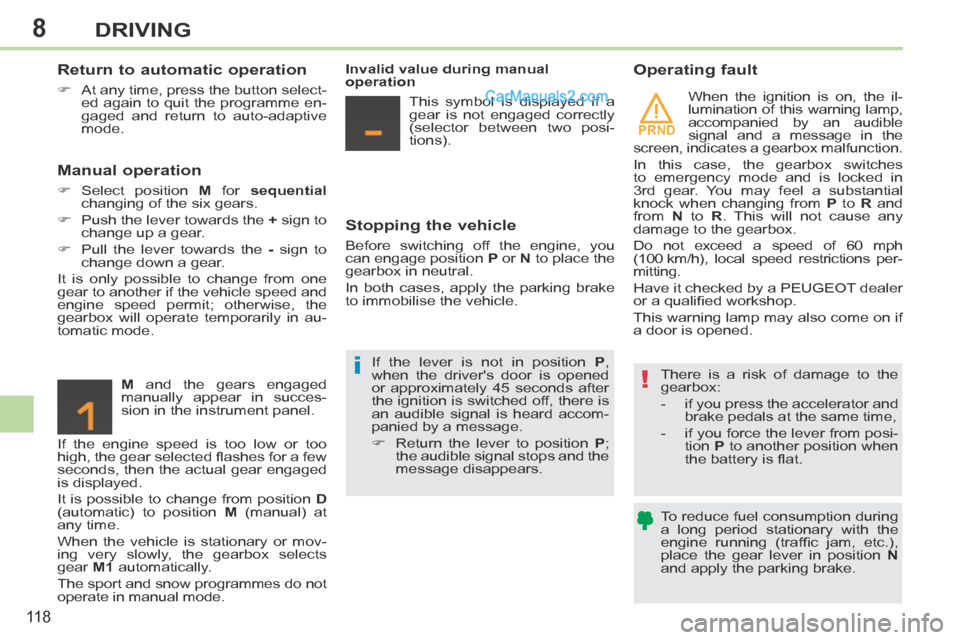
8
PRND
!i
11 8
DRIVING
Return to automatic operation
At any time, press the button select-ed again to quit the programme en-
gaged and return to auto-adaptive
mode.
Manual operation
Select position M for sequential
changing of the six gears.
Push the lever towards the + sign to
change up a gear.
Pull the lever towards the - sign to
change down a gear.
It is only possible to change from one
gear to another if the vehicle speed and
engine speed permit; otherwise, the
gearbox will operate temporarily in au-
tomatic mode.
M and the gears engaged
manually appear in succes-
sion in the instrument panel.
If the engine speed is too low or too
high, the gear selected fl ashes for a few
seconds, then the actual gear engaged
is displayed.
It is possible to change from position D
(automatic) to position M (manual) at
any time.
When the vehicle is stationary or mov-
ing very slowly, the gearbox selects
gear M1 automatically.
The sport and snow programmes do not
operate in manual mode. Invalid value during manual
operation
This symbol is displayed if a
gear is not engaged correctly
(selector between two posi-
tions).
Stopping the vehicle
Before switching off the engine, you
can engage position P or N to place the
gearbox in neutral.
In both cases, apply the parking brake
to immobilise the vehicle.
Operating fault
There is a risk of damage to the
gearbox:
- if you press the accelerator and brake pedals at the same time,
- if you force the lever from posi- tion P to another position when
the battery is fl at.
To reduce fuel consumption during
a long period stationary with the
engine running (traffi c jam, etc.),
place the gear lever in position N
and apply the parking brake.
If the lever is not in position
P ,
when the driver's door is opened
or approximately 45 seconds after
the ignition is switched off, there is
an audible signal is heard accom-
panied by a message.
Return the lever to position P ;
the audible signal stops and the
message disappears. When the ignition is on, the il-
lumination of this warning lamp,
accompanied by an audible
signal and a message in the
screen, indicates a gearbox malfunction.
In this case, the gearbox switches
to emergency mode and is locked in
3rd gear. You may feel a substantial
knock when changing from P to R and
from N to R . This will not cause any
damage to the gearbox.
Do not exceed a speed of 60 mph
(100 km/h), local speed restrictions per-
mitting.
Have it checked by a PEUGEOT dealer
or a qualifi ed workshop.
This warning lamp may also come on if
a door is opened.
Page 121 of 268
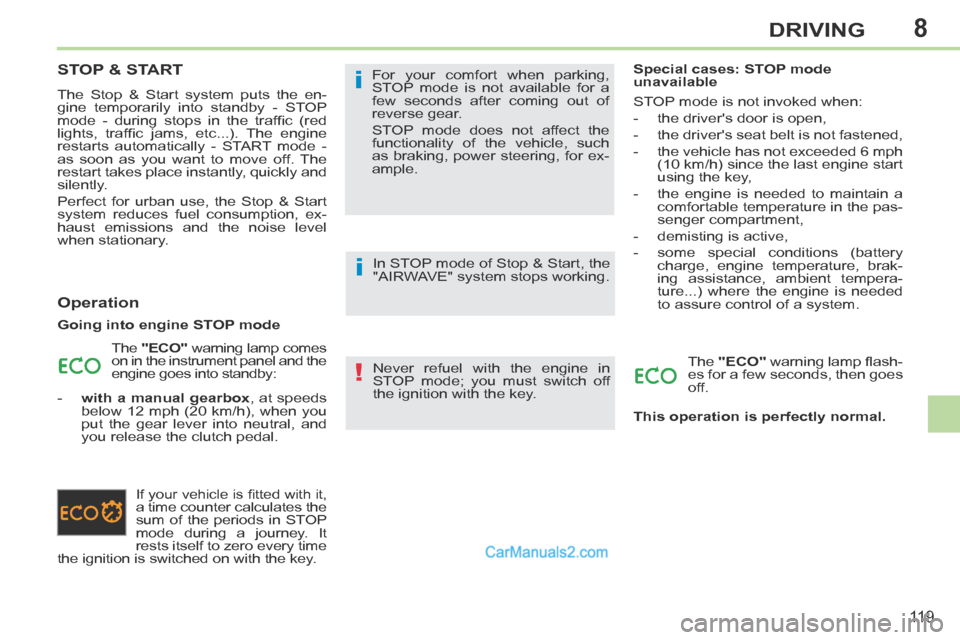
8
!
i
i
11 9
DRIVING
STOP & START
The Stop & Start system puts the en-
gine temporarily into standby - STOP
mode - during stops in the traffi c (red
lights, traffi c jams, etc...). The engine
restarts automatically - START mode -
as soon as you want to move off. The
restart takes place instantly, quickly and
silently.
Perfect for urban use, the Stop & Start
system reduces fuel consumption, ex-
haust emissions and the noise level
when stationary.
Operation
Going into engine STOP mode The "ECO" warning lamp comes
on in the instrument panel and the
engine goes into standby:
- with a manual gearbox , at speeds below 12 mph (20 km/h), when you
put the gear lever into neutral, and
you release the clutch pedal.
If your vehicle is fi tted with it, a time counter calculates the
sum of the periods in STOP
mode during a journey. It
rests itself to zero every time
the ignition is switched on with the key. For your comfort when parking,
STOP mode is not available for a
few seconds after coming out of
reverse gear.
STOP mode does not affect the
functionality of the vehicle, such
as braking, power steering, for ex-
ample.
Never refuel with the engine in
STOP mode; you must switch off
the ignition with the key. Special cases: STOP mode
unavailable
STOP mode is not invoked when:
- the driver's door is open,
- the driver's seat belt is not fastened,
- the vehicle has not exceeded 6 mph
(10 km/h) since the last engine start
using the key,
- the engine is needed to maintain a comfortable temperature in the pas-
senger compartment,
- demisting is active,
- some special conditions (battery charge, engine temperature, brak-
ing assistance, ambient tempera-
ture...) where the engine is needed
to assure control of a system.
The "ECO" warning lamp fl ash-
es for a few seconds, then goes
off.
This operation is perfectly normal.
In STOP mode of Stop & Start, the
"AIRWAVE" system stops working.